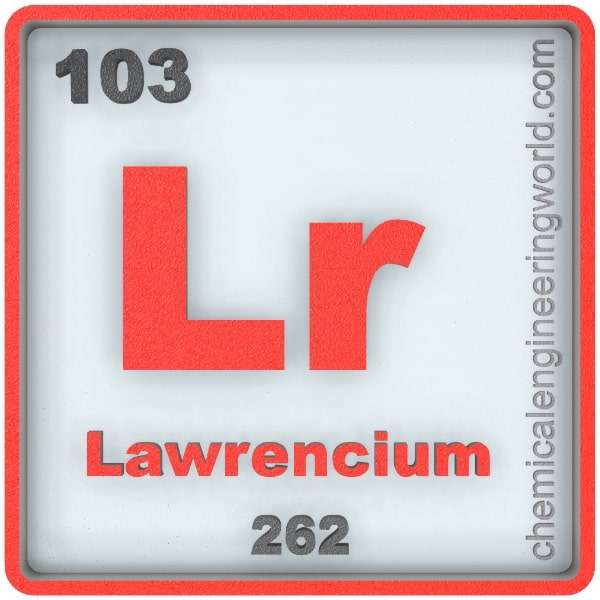Lawrencium Element Properties and Information

Lawrencium Element Properties and Information
Lawrencium is 103rd element on the periodic table. Elements are arranged in the periodic table on the basis of the atomic number. Atomic number is the number of protons in the nucleus of the atom. Lawrencium has an atomic number of 103. It is located in the Group ‘Actinides’ and Period 7 of the periodic table of elements and denoted by the symbol ‘Lr’. Lawrencium is named after Ernest O. Lawrence, the inventor of the cyclotron.
Soviet Union’s Joint Institute for Nuclear Research (JINR) were the first to discover Lawrencium as the isotope lawrencium-258, they did so by bombarding americium with oxygen. The Lawrence Berkely Laboratory (LBL) produced the isotope lawrencium-257 by bombarding curium with boron. Lawrencium is not found naturally in the Earth’s crust. Neither can it be made in a nuclear reactor. Lawrencium can only be synthesized in a particle accelerator such as cyclotron.
Physical Properties
- Lawrencium is the final element of the actinide series. It lies to the right of nobelium and left of rutherfordium on the periodic table.
- The atomic mass of lawrencium is (262).
- The melting point of lawrencium is unknown as of yet.
- The boiling point of lawrencium is unknown as of yet.
- The density of lawrencium is unknown as of yet.
- Lawrencium is said to share many physical properties with lutetium.
- Lawrencium’s atomic volume is similar to that of lawrencium.
- Lawrencium is expected to have a silvery appearance.
- Lawrencium is expected to be solid under normal temperature and pressure conditions.
- Lawrencium is expected to have hexagonally closed-packed structure similar to that of lutetium.
- Nearly 14 isotopes of lawrencium have been characterized so far.
Chemical Properties
- Lawrencium metal is expected to easily get oxidized by air, steam, and acids.
- Lawrencium is said to share many chemical properties with lutetium.
- Lawrencium’s enthalpy of sublimation is similar to that of lutetium.
- The stability of lawrencium(III) compounds in aqueous solution is similar to that of lutetium(III) compounds.
- Lawrencium is observed to chloride, fluoride, hydroxide, and hydride.
Methods of Production
Particle Accelerator: All the elements which have atomic number greater than 100 can only be prepared through reactions in a particle accelerator such as a cyclotron; they are not formed in a nuclear reactor. The lightest isotopes of lawrencium, lawrencium-251 to lawrencium-254 are formed as alpha decay products of dubnium. The middle isotopes of lawrencium, lawrencium-255 to lawrencium-262, are prepared by bombarding the actinide elements ranging from americium to einsteinium with light ions ranging from boron to neon. The heaviest isotopes of lawrencium, lawrencium-264 to lawrencium-266, are produced in a manner same as lighter lawrencium isotopes.
Relevance in Chemical & Related Industries
Lawrencium has no relevant use in chemical & related industries.
Relevance in Other Industries
Research: Lawrencium has relevance only in the field of research.
Health Effects on Exposure
Lawrencium doesn’t occur naturally hence there is no reason to study its effects on health.
Effects on Surroundings
Lawrencium does not occur in Earth’s crust hence there is no reason to study its effects on environment.
References:
https://en.wikipedia.org/wiki/Lawrencium
https://www.lenntech.com/periodic/elements/lr.htm
































